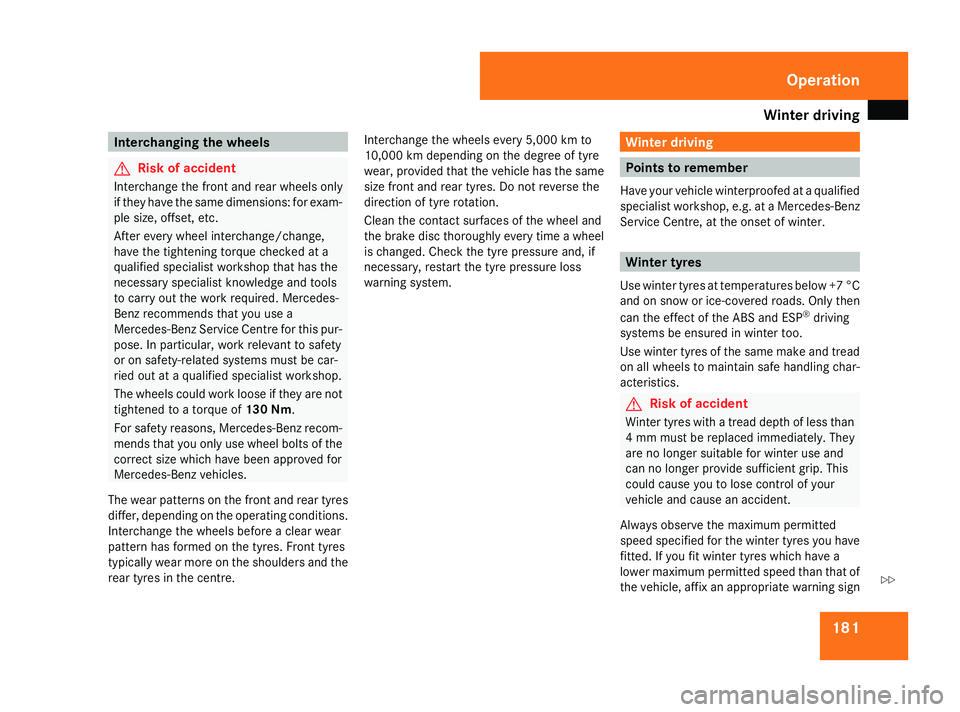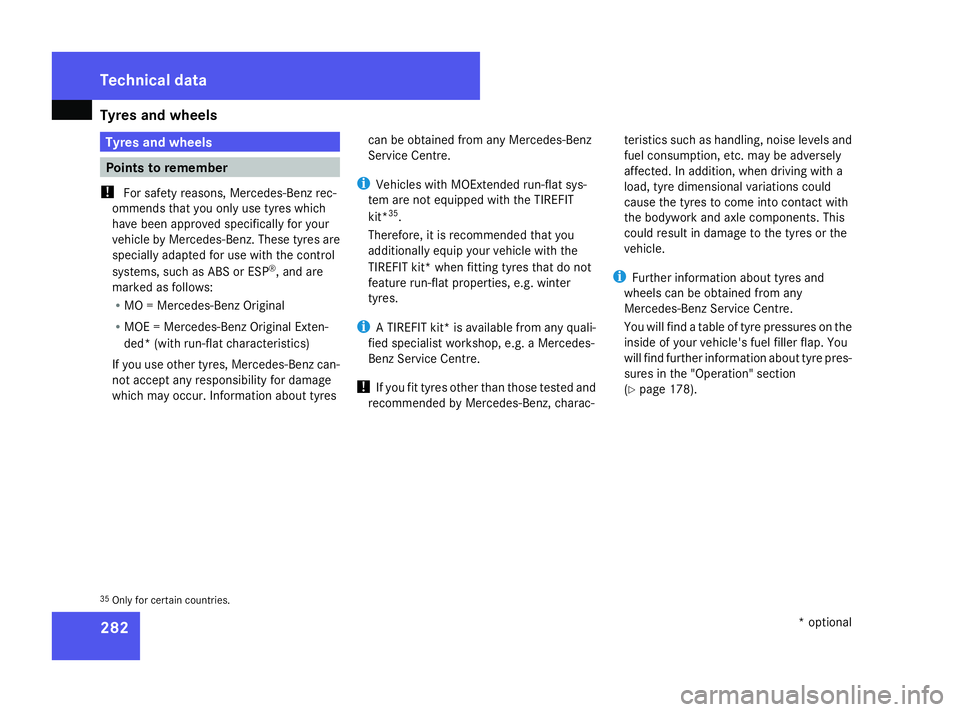Page 184 of 305

Winter driving
181Interchanging the wheels
G
Risk of accident
Interchange the front and rear wheels only
if they have the same dimensions: for exam-
ple size, offset, etc.
After every wheel interchange/change,
have the tightening torque checked at a
qualified specialist workshop that has the
necessary specialist knowledge and tools
to carry out the work required. Mercedes-
Benz recommends that you use a
Mercedes-Benz Service Centre for this pur-
pose. In particular, work relevant to safety
or on safety-related systems must be car-
ried out at a qualified specialist workshop.
The wheels could work loose if they are not
tightened to a torque of 130 Nm.
For safety reasons, Mercedes-Benz recom-
mends that you only use wheel bolts of the
correct size which have been approved for
Mercedes-Benz vehicles.
The wear patterns on the front and rear tyres
differ, depending on the operating conditions.
Interchange the wheels before a clear wear
pattern has formed on the tyres. Front tyres
typically wear more on the shoulders and the
rear tyres in the centre. Interchange the wheels every 5,000 km to
10,000 km depending on the degree of tyre
wear, provided that the vehicle has the same
size front and rear tyres. Do not reverse the
direction of tyre rotation.
Clean the contact surfaces of the wheel and
the brake disc thoroughly every time a wheel
is changed. Check the tyre pressure and, if
necessary, restart the tyre pressure loss
warning system. Winter driving
Points to remember
Have your vehicle winterproofed at a qualified
specialist workshop, e.g. at a Mercedes-Benz
Service Centre, at the onset of winter. Winter tyres
Use winter tyres at temperatures below +7 °C
and on snow or ice-covered roads. Only then
can the effect of the ABS and ESP ®
driving
systems be ensured in winter too.
Use winter tyres of the same make and tread
on all wheels to maintain safe handling char-
acteristics. G
Risk of accident
Winter tyres with a tread depth of less than
4 mm must be replaced immediately. They
are no longer suitable for winter use and
can no longer provide sufficient grip. This
could cause you to lose control of your
vehicle and cause an accident.
Always observe the maximum permitted
speed specified for the winter tyres you have
fitted. If you fit winter tyres which have a
lower maximum permitted speed than that of
the vehicle, affix an appropriate warning sign Operation
169_AKB; 2; 4, en-GB
wdomann,
Version: 2.10.6 2008-07-16T08:52:06+02:00 - Seite 181 ZDateiname: 6515_0315_02_buchblock.pdf; preflight
Page 207 of 305
Display
messages 204 Display messages Possible cause/consequence Possible solution
120 km/h Maximum speed
exceeded The maximum speed has been excee-
ded
26
. X
Drive slower. ABS ABS, ESP unavaila-
ble See Owner's
Manual
G
Risk of accident
ABS (Anti-lock Brake System) and ESP ®
(Electronic Stability Program) are tempo-
rarily unavailable. The self-diagnosis is, for
example, not yet complete.
The following systems are also unavaila-
ble:
R BAS (Brake Assist)
R the steering assistant STEER CONTROL
R hill start assist
R the tyre pressure loss warning system
The brake system continues to function
normally, but without the functions listed
above. X
Carefully drive a short, lightly curving stretch
of road at a speed above 20 km/h.
If the display message disappears, ABS and
ESP ®
are available again. 26
Only for certain countries. Practical advice
169_AKB; 2; 4, en-GB
wdomann
,V ersion: 2.10.6
2008-07-16T08:52:06+02:00 - Seite 204 Dateiname: 6515_0315_02_buchblock.pdf; preflight
Page 208 of 305
Display
messages 205Display messages Possible cause/consequence Possible solution
G
Risk of accident
ABS and ESP ®
are temporarily unavailable
due to undervoltage. The battery is, for
example, not being charged.
The following systems are also unavaila-
ble:
R BAS
R the steering assistant STEER CONTROL
R hill start assist
R the tyre pressure loss warning system
The brake system continues to function
normally, but without the functions listed
above. X
Drive on carefully.
X Visit a qualified specialist workshop immedi-
ately.
X Observe the additional messages in the multi-
function display ( Ypage 202). Practical advice
169_AKB; 2; 4, en-GB
wdomann
,V ersion: 2.10.6
2008-07-16T08:52:06+02:00 - Seite 205 ZDateiname: 6515_0315_02_buchblock.pdf; preflight
Page 209 of 305
Display
messages 206 Display messages Possible cause/consequence Possible solution
ABS ABS, ESP inopera-
tive See Owner's
Manual
G
Risk of accident
ABS and ESP ®
are unavailable due to a
fault.
The following systems are also unavaila-
ble:
R BAS
R the steering assistant STEER CONTROL
R hill start assist
R the tyre pressure loss warning system
The brake system continues to function
normally, but without the functions listed
above. X
Drive on carefully.
X Visit a qualified specialist workshop immedi-
ately. Practical advice
169_AKB; 2; 4, en-GB
wdomann
,V ersion: 2.10.6
2008-07-16T08:52:06+02:00 - Seite 206 Dateiname: 6515_0315_02_buchblock.pdf; preflight
Page 227 of 305

Troubleshooting
224 Warning and indicator lamps in the instrument cluster
Problem Possible cause/consequence Suggested solutions
-
Theyellow ABS warning
lamp comes on while the
engine is running. G
Risk of accident
ABS (Anti-lock Brake System) is
deactivated due to a fault. There-
fore, ESP ®
(Electronic Stability
Program), BAS (Brake Assist), the
steering assistant STEER CON-
TROL, the hill start assist and the
tyre pressure loss warning sys-
tem are also deactivated.
The brake system continues to
function normally, but without
electronic support. The wheels
could therefore lock if you brake
hard.
If the ABS control unit is faulty,
other systems may also not be
available: e.g. Parktronic sys-
tem*, the navigation system* or
the Autotronic*. X
Drive on carefully.
X Observe the additional messages in the multi-function display
(Y page 202).
X Visit a qualified specialist workshop. -
The yellow ABS warning
lamp comes on while the
engine is running. G
Risk of accident
The on-board voltage is too low.
ABS has been deactivated due to
undervoltage. X
Switch off consumers that are not required, e g. reading lamps or
interior lighting.
ABS will be available again as soon as the vehicle's electrical sys-
tem voltage increases. Practical advice
* optional
169_AKB; 2; 4, en-GB
wdomann
,V ersion: 2.10.6
2008-07-16T08:52:06+02:00 - Seite 224 Dateiname: 6515_0315_02_buchblock.pdf; preflight
Page 285 of 305

Tyres and wheels
282 Tyres and wheels
Points to remember
! For safety reasons, Mercedes-Benz rec-
ommends that you only use tyres which
have been approved specifically for your
vehicle by Mercedes-Benz. These tyres are
specially adapted for use with the control
systems, such as ABS or ESP ®
, and are
marked as follows:
R MO = Mercedes-Benz Original
R MOE = Mercedes-Benz Original Exten-
ded* (with run-flat characteristics)
If you use other tyres, Mercedes-Benz can-
not accept any responsibility for damage
which may occur. Information about tyres can be obtained from any Mercedes-Benz
Service Centre.
i Vehicles with MOExtended run-flat sys-
tem are not equipped with the TIREFIT
kit* 35
.
Therefore, it is recommended that you
additionally equip your vehicle with the
TIREFIT kit* when fitting tyres that do not
feature run-flat properties, e.g. winter
tyres.
i A TIREFIT kit* is available from any quali-
fied specialist workshop, e.g. a Mercedes-
Benz Service Centre.
! If you fit tyres other than those tested and
recommended by Mercedes-Benz, charac- teristics such as handling, noise levels and
fuel consumption, etc. may be adversely
affected. In addition, when driving with a
load, tyre dimensional variations could
cause the tyres to come into contact with
the bodywork and axle components. This
could result in damage to the tyres or the
vehicle.
i Further information about tyres and
wheels can be obtained from any
Mercedes-Benz Service Centre.
You will find a table of tyre pressures on the
inside of your vehicle's fuel filler flap. You
will find further information about tyre pres-
sures in the "Operation" section
(Y page 178).
35 Only for certain countries. Techni
cal data
* optional
169_AKB; 2; 4, en-GB
wdomann,
Version: 2.10.6
2008-07-16T08:52:06+02:00 - Seite 282 Dateiname: 6515_0315_02_buchblock.pdf; preflight
Page 303 of 305

Service products and capacities
300 Brake fluid
Over a period of time, the brake fluid absorbs
moisture from the air; this lowers its boiling
point. G
Risk of accident
If the boiling point of the brake fluid is too
low, vapour pockets may form in the brake
system when the brakes are applied hard
(e.g. when driving downhill). This would
impair braking efficiency.
Have the brake fluid renewed every two
years with a brake fluid that has been
approved by Mercedes-Benz and have this
confirmed in the Service Booklet.
i There is usually a notice in the engine
compartment to remind you when the next
brake fluid change is due. Windscreen washer system
G
Risk of fire
Windscreen washer concentrate is highly
flammable. Fire, naked flames and smoking
are prohibited when windscreen washer
concentrate is being handled.
The washer fluid reservoir holds approxi-
mately 4.5 litres.
The headlamp cleaning system* and the
windscreen washer system are both supplied
from the washer fluid reservoir.
Further information on windshield washer
fluid and the mixing ratio can be found on
(Y page 175). Technical data
* optional
169_AKB; 2; 4, en-GB
wdomann,
Version: 2.10.6
2008-07-16T08:52:06+02:00 - Seite 300 Dateiname: 6515_0315_02_buchblock.pdf; preflight